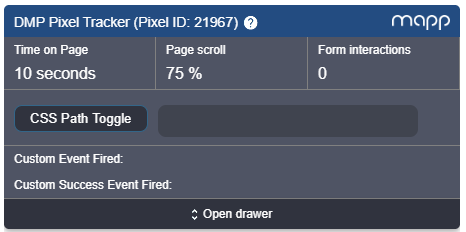This section covers all information about the Implementation of the DMP Pixels.
...
An important step of the implementation is to check whether the pixel is implemented correctly and the data is being collected properly. In order to do so the DMP includes a feature to verify the DMP pixel loads in a user-friendly way and without the need for developer skills. The Pixel Activity Monitor can be enabled as an On-Site pixel module and serves as a tool to verify the DMP pixel is active on the website. It will pop-up as a floating and draggable element in your browser and shows all data events that are initiated by the implemented pixel script. This also includes interaction events like ‘Time on Page’, ‘Page Scroll’, and ‘Form Interactions’ that are originating from the default pixel modules. Please note that this module is not available by default.
A step-by-step guide on how to enable the Pixel Activity Monitor:
...
- Required: The "id", "m" and "pl" parameters are required and static in a sense that they may not be changed. The "id" represents the pixel_id, the "m" represents the customer_id that is assigned to your DMP instance ID (this will always be the same for your account) and the "pl" represents the "platform" for which you exported an impression tracking pixel.
- Optional: The impression trackers pixels can be customized to a large extent by means of predefined parameters as part of our log format.
Macros
Creative macros allow you to transmit impression-level information to systems outside of the execution platform - in this case our DMP - which you can then use for audience building purposes, reporting and/or campaign optimization. In this example, you would like to capture information about the advertising campaign and inventory you're buying and store it in our DMP.
...
- Required: The "id", "m" and "pl" parameters are required and static in a sense that they may not be changed. The "id" represents the pixel_id, the "m" represents the customer_id that is assigned to your DMP instance ID (this will always be the same for your account) and the "pl" represents the "platform" for which you exported a click tracking pixel. The "cid" and "out" parameters are also required but may be dynamically populated. The "cid" respresents the creative_id of the ad unit and the "out" parameter initiates a redirect to the landing page URL. Therefore, the "out" parameter should always be the last element of the Click Tracking Pixel and the value must be either the actual URL of the landing page or a macro that populates the landing page url automatically.
- Optional: The impression trackers pixels can be customized to a large extent by means of predefined parameters as part of our log format.
Macros
Creative macros allow you to transmit impression-level information to systems outside of the execution platform - in this case our DMP - which you can then use for audience building purposes, reporting and/or campaign optimization. In this example, you would like to capture information about the advertising campaign and inventory you're buying and store it in our DMP.
...
